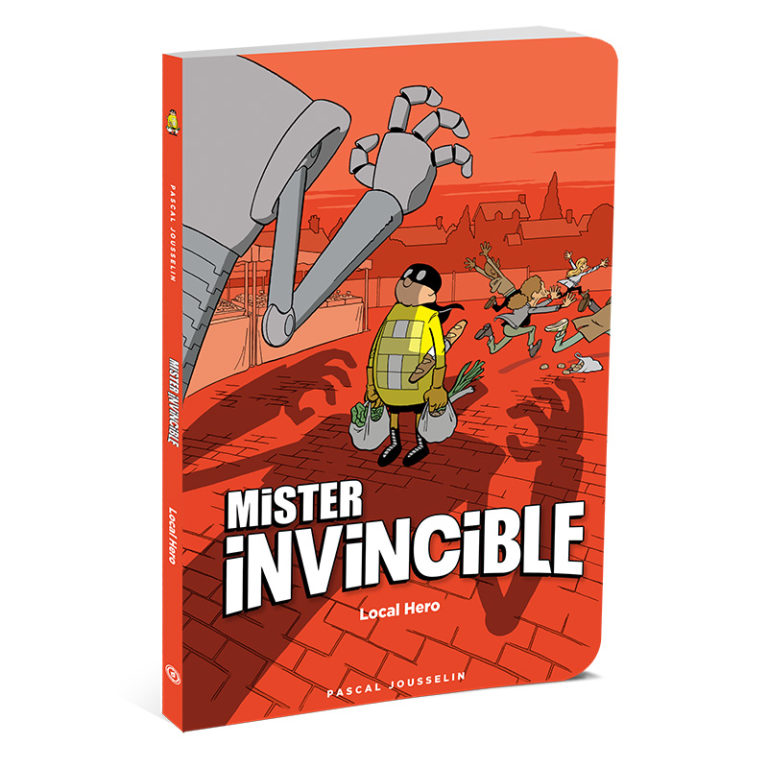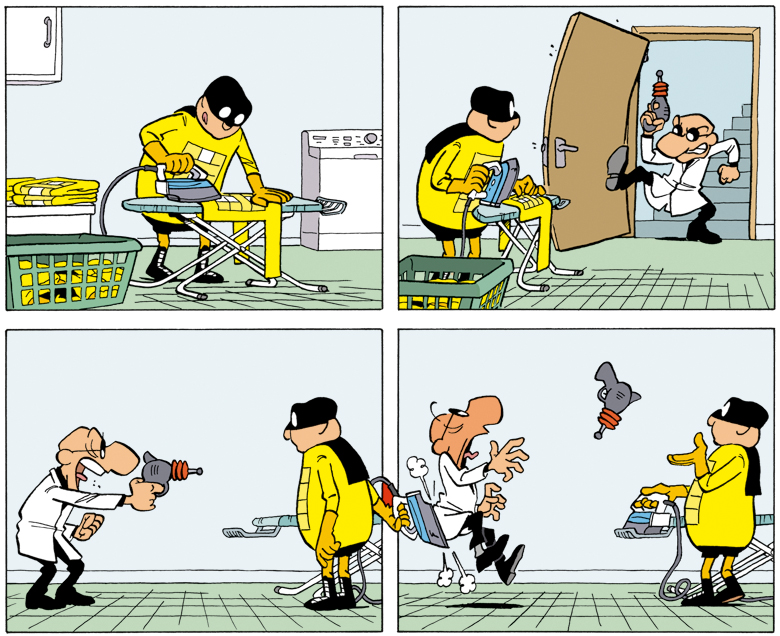NOVEMBER 12, 2020 BY ELIZABETH BIRD PUBLISHED ORIGINALLY ON SCHOOL LIBRARY JOURNAL

Mister Invincible: Local Hero
By Pascal Jousselin
Colored by Laurence Croix
Translated by David Bryon, James Hogan, and Ivanka T. Hahnenberger
Magnetic Press
$15.99
ISBN: 978-1-942367-61-1
On shelves now
My 9-year-old has proven herself to be a good judge of a comic book’s character. Thanks to both my current job working in a library and the state of children’s graphic novel publishing at this point in the 21st century, I am now able to come home on a regular basis with comics for my kids. With such bounty comes a more critical eye, though. My daughter has often told me, in no uncertain terms, that she finds far too many of the books I bring to be very similar. “They all look the same,” she might complain. Or, if the book has some kind of quest/magical element she’ll tell me that they feel the like they’re just following the same pattern. Maybe that’s why as a family we’ve grown so fond of some of the French comic imports published this year. The Runaway Princess by Johan Troïanowski provided this kaleidoscope of wild colors and mildly baffling plots. Meanwhile The Postman From Space by Guillaume Perreault is this marvelous younger story that isn’t afraid to write something for the smaller children out there. Even Aster and the Accidental Magic by Thom Pico, ill. Karensac goes in strange, wholly original directions, though in many ways it’s the most standardized of the imports. But the comic that stands above the pack, that no one can beat in terms of timing, humor, and sheer brainpower, is none other than the winner of the Bologna Ragazzi Comics Award for Middle Grades of 2020, Mister Invincible: Local Hero. “Mom!” my daughter exclaimed after reading just one or two pages, “This doesn’t look like anything else!” That’s the least of it, kid. This book? It doesn’t READ like anything else out there either.

He can’t fly. Doesn’t particularly care to move fast. He’s not super strong or have a massive brain. So what’s Mister Invincible’s power? Well, when you live on the pages of a comic and are the only one aware of the situation, you’d be amazed how much trouble you can get out of (and into). In this collection of Mister Invincible stories, readers will watch as gutters, panels, speech balloons, backgrounds, and more become tools for Mister Invincible and his friends. Mad scientists beware. As our hero says, “I’m invincible. Some day you’ll get it.”
In his New York Times review of the book, Gene Luen Yang talks about the degree to which Mister Invincible plays with the comic format form. He makes some comparisons to Scott McCloud, which makes perfect sense, and then points out that in this book you get the distinct feeling that Jousselin is trying to figure out how far he can push the comic form. Generally speaking, I’d say his experiments work. Both Mister Invincible’s allies and some of his enemies are capable of operating in a comic format, making it work to their own best advantage. On the good guys’ side you have an old bocce ball player (just in case you’d forgotten this book was French) whose speech balloons take on a life of their own when he’s peeved. Then there’s Toodee, a proto superhero in training who can treat the backgrounds of comic book scenes as if there had no perspective at all and the objects were just very small. On the side of the baddies is a villain that can go through the page to the other side with ease. The only character I felt didn’t quite work was the woman who lives backwards. It’s a neat idea, since Jousselin is basically playing with the entire nature of sequential art, but he kind of had to make too many exceptions for her for the storyline to continue. That may be why she only makes one appearance and then disappears for good.

The technical aspects of a book are the parts that will earn it its easiest praise. Far more difficult is tone. How does a comic creator come up with the right tone for a piece? In this, everything comes down to Mister Invincible himself. He does not cut a particularly striking figure. His shirt, which I now realize is a series of panels, surrounds a nicely rounded body. You’ll rarely see him run or even attempt to fight in earnest. Moreover his mask keeps his eyes a calm blank white. When he’s not speaking his mouth is prone to completely disappearing. In general, he approaches life with a relaxed, casual manner. Should he need to dive down to save someone, he’ll do it in a pinch, but on the whole we should all be so lucky as to emulate the massively laid back Mister Invincible.
As with any creator, you may sometimes find yourself wondering what their influences are when you look at their work. Pascal Jousselin isn’t prone to doing interviews with English speakers, however, so if his style feels like a modified Tintin comic, that may just be a coincidence. In creating this book, however, the story is long. Initially called Imbattable, in 2013 Mister Invincible appeared in “Spirou” magazine. In time, these strips were collected and put together into books. The book Mister Invincible retains that serialized feel. Though characters and the occasional plot do continue from scene to scene, on the whole each section is fairly self-contained. I am a firm believer in the idea that limitations feed creativity more effectively than absolute freedom. In the case of Jousselin, he’s not just playing around with panels and moving between and within them. Occasionally the Mad Scientist (Mister Invincible’s number one ineffectual enemy) will invent something that changes the physical nature of the book itself. He might shoot a laser and melt three panels (the paper of the book now has gaps you can see through) or create a machine that will split reality into two parts (which means a gatefold for the two different storylines).

Children like books that respect their intelligence. And books that challenge them can sometimes be even better. There are times when Mister Invincible makes you feel like you’re a smarter person, simply for figuring out what’s going on in a page. There is no equivalent. The book that comes to mind when I try to find anything similar would have to be Jason Shiga’s Meanwhile and even that nihilistic spree doesn’t really have the same feel as Jousselin’s. This is the comic you hand to the kids that, like my daughter, complain about how everything feels all samey. The kids that wish there were books that tested them a little. The kids that want a comic that can inspire them to create stories that go beyond the usual boundaries. Without a doubt, this is one of the most original books I’ve read for kids, teens, adults, you name it, in years. Incroyable? You don’t know the half of it.
Source: Book checked out from library for review.
Professional Reviews: Read Gene Luen Yang’s assessment of the book in the New York Times here.
BROWSE OUR DAYTIME TITLES

A FULL LINE-UP OF “DAYTIME PROGRAMMING” FOR YOUNGER VIEWERS!
The Daytime Collection offers titles for young readers of different levels up to age 16.


